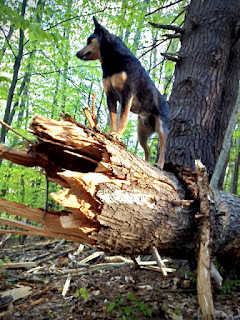Here is my article on Runaway Syndrome.
With all the people adopting dogs during the pandemic, this is especially important information. Runaway Syndrome can affect any breed or individual, it happens specifically during the time when they are removed from their current familiar home location. It’s most often seen from dogs that have once had homes, but have then been left at a shelter/rescue. It can also happen when a dog is left at a different location when their owners go on vacation.
Frequently dogs are adopted out to loving families, but they may be startled by a strange noise or object and panic. Even just the unfamiliar new home itself can be enough to cause a dog to bolt at the first opportunity. They often search for the last place they remember, which may in fact be the shelter/rescue.
An unintentionally left open house door or gate, by breaking through a screen window, jumping out an open car door, or digging under/jumping over a fenced in yard are all common scenarios of escape.
It can take weeks or even months before a dog accepts their new home, and is content to stay there.
BE PROACTIVE
-Have a current clear, color photo of the dog. Note any distinct markings, plus the past name the dog had if it’s an owner surrendered animal.
-If possible bring the dog’s bed/blanket,toys,crate, anything that has their scent on it will help make the transition to a new home go smoother.
-Be highly vigilant about keeping the dog on a secure lead, even in a fenced area.
-Microchipping a dog is often done as a form of permanent identification, new owners MUST renew the paperwork in their own name, as most shelters/rescues dispose of all the dog’s information once they are placed in a new home.
-Yearly microchip conformation number scan should be done when your dog gets their vaccinations at the Veterinary clinic.
- Have all the local animal control, rescues, shelters, Veterinarians, and microchip registry phone numbers readily available in your phone and or your address book.
-Smart collars can be very useful, as they are GPS units which send the information of the dog’s whereabouts directly to your phone.
-Have a properly fitted ( snug enough that they cannot slip their head out of) collar on the dog. It is easier for person to grab hold of the collar on a loose dog , and it provides vital information. A flat buckle or martingale collar, embroidered with dog’s name and your phone number are the best. Second best would be an engraved tag riveted to a collar, third best would be a dog tag hanging from a collar. Dogs who are licensed can be traced if they are wearing a tag when they are found.
WHAT TO DO IF YOUR DOG RUNS AWAY
- The first 24 hours are the most critical in finding the dog. Take the day off work if at all possible to search for the dog. Dogs often go into survival mode quickly once they are on their own, and may need to be live trapped to catch them again once this happens.
Often shelters have a limited number of days they keep a stray dog before it is euthanized.
-Call the local shelters,rescues, dog warden/animal control, veterinarian clinics, and police. Give a detailed description of the dog, repeat daily until the dog is found.
- Create a search party, talk to local neighbors as they may have seen the dog, plus dogs will often hide in a quiet area nearby.
-Post on social media, and neighborhood networking services.
- Enter dog’s microchip number into the registry.
-Print out and distribute large flyers with a photo of the dog, their name, and your phone number on it. Make business card sized handouts to pass out and post.
-Don’t give up searching, often dogs are picked up by travelers and can show up hundreds of miles away. As long as there is still hope, there is a chance of recovering the dog.
NEVER punish the dog once you catch them (no matter how mad or upset you may be) because this will only increase the chances of them running off again. Because dogs live in the moment the dog doesn’t understand that you are angry it took off, and it will only respond to the current reaction of when it’s caught.
RECOMMENDED TRAINING
Start working immediately with your new dog.
Train a solid recall command.
Impulse control exercises like PLACE command are extremely helpful.
Barrier threshold training for both car and home can be a lifesaver for your dog.
All of the above exercises are in detailed articles, plus one specificity on Lost Dog Recovery are available at my site below, which is open to the public and free of charge. ❤️🐺❤️










No comments:
Post a Comment